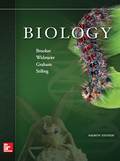
Concept explainers
Introduction: Microscopic, branched filaments known as hyphae form a distinctive body of
Answer to Problem 1TY
Correct answer: Both fungal and animal cells are eukaryotic in nature. However, the absence of cell walls in the animal cells distinguish them from the fungal cells. Hence, the correct answer is option c.
Explanation of Solution
Reason for correct answer:
Fungal cells have a rigid layer external to the plasma membrane called cell wall. The cell wall of fungi is made up of chitin and they play role in the protection of cells. This protective layer is absent in animal cells.
Option c. is given as “have chitin-rich cell walls, whereas animal cells lack cell walls”.
The presence of chitin-rich cell walls in the fungal cells differentiates them from the animal cells. Hence, the correct answer is option c.
Reasons for incorrect answer:
Option a. is given as, “lack ribosomes, though these are present in animal cells”.
The cells of fungi are eukaryotic in nature. Therefore, like animal cells, fungi also contain ribosome, a cell organelle. Hence, option a. is incorrect.
Option b. is given as, “lack mitochondria, though these occur in animal cells”.
Cell organelles such as mitochondria are required to provide energy to the cell in the form of ATP molecules and are present in all eukaryotic cells including the animal cells and fungal cells. Hence, option b. is incorrect.
Option d. is given as, “lack cell walls, whereas animal cells possess cell walls”.
Fungal cells have a protective layer in the form of a cell wall, which is mainly composed of chitin. However, animal cells do not have cell walls. The organelles present in the animal cells are enclosed within a phospholipid bilayer known as the plasma membrane. Hence, option d. is incorrect.
Option e. is given as, “none of the above is true”.
Fungal cells possess cell walls made up of chitin and it is absent in the animal cells. This makes option c. correct. Hence, option e. is incorrect.
Hence, the options a., b., d., and e. are incorrect.
Thus, cell walls mainly composed of chitin is present in fungal cells, but it is absent in the animal cells.
Want to see more full solutions like this?
- What symbolic and cultural behaviors are evident in the archaeological record and associated with Neandertals and anatomically modern humans in Europe beginning around 35,000 yBP (during the Upper Paleolithic)?arrow_forwardDescribe three cranial and postcranial features of Neanderthals skeletons that are likely adaptation to the cold climates of Upper Pleistocene Europe and explain how they are adaptations to a cold climate.arrow_forwardBiology Questionarrow_forward
- ✓ Details Draw a protein that is embedded in a membrane (a transmembrane protein), label the lipid bilayer and the protein. Identify the areas of the lipid bilayer that are hydrophobic and hydrophilic. Draw a membrane with two transporters: a proton pump transporter that uses ATP to generate a proton gradient, and a second transporter that moves glucose by secondary active transport (cartoon-like is ok). It will be important to show protons moving in the correct direction, and that the transporter that is powered by secondary active transport is logically related to the proton pump.arrow_forwarddrawing chemical structure of ATP. please draw in and label whats asked. Thank you.arrow_forwardOutline the negative feedback loop that allows us to maintain a healthy water concentration in our blood. You may use diagram if you wisharrow_forward
- Give examples of fat soluble and non-fat soluble hormonesarrow_forwardJust click view full document and register so you can see the whole document. how do i access this. following from the previous question; https://www.bartleby.com/questions-and-answers/hi-hi-with-this-unit-assessment-psy4406-tp4-report-assessment-material-case-stydu-ms-alecia-moore.-o/5e09906a-5101-4297-a8f7-49449b0bb5a7. on Google this image comes up and i have signed/ payed for the service and unable to access the full document. are you able to copy and past to this response. please see the screenshot from google page. unfortunality its not allowing me attch the image can you please show me the mathmetic calculation/ workout for the reult sectionarrow_forwardIn tabular form, differentiate between reversible and irreversible cell injury.arrow_forward
 Biology: The Dynamic Science (MindTap Course List)BiologyISBN:9781305389892Author:Peter J. Russell, Paul E. Hertz, Beverly McMillanPublisher:Cengage Learning
Biology: The Dynamic Science (MindTap Course List)BiologyISBN:9781305389892Author:Peter J. Russell, Paul E. Hertz, Beverly McMillanPublisher:Cengage Learning Biology (MindTap Course List)BiologyISBN:9781337392938Author:Eldra Solomon, Charles Martin, Diana W. Martin, Linda R. BergPublisher:Cengage Learning
Biology (MindTap Course List)BiologyISBN:9781337392938Author:Eldra Solomon, Charles Martin, Diana W. Martin, Linda R. BergPublisher:Cengage Learning Biology Today and Tomorrow without Physiology (Mi...BiologyISBN:9781305117396Author:Cecie Starr, Christine Evers, Lisa StarrPublisher:Cengage Learning
Biology Today and Tomorrow without Physiology (Mi...BiologyISBN:9781305117396Author:Cecie Starr, Christine Evers, Lisa StarrPublisher:Cengage Learning





